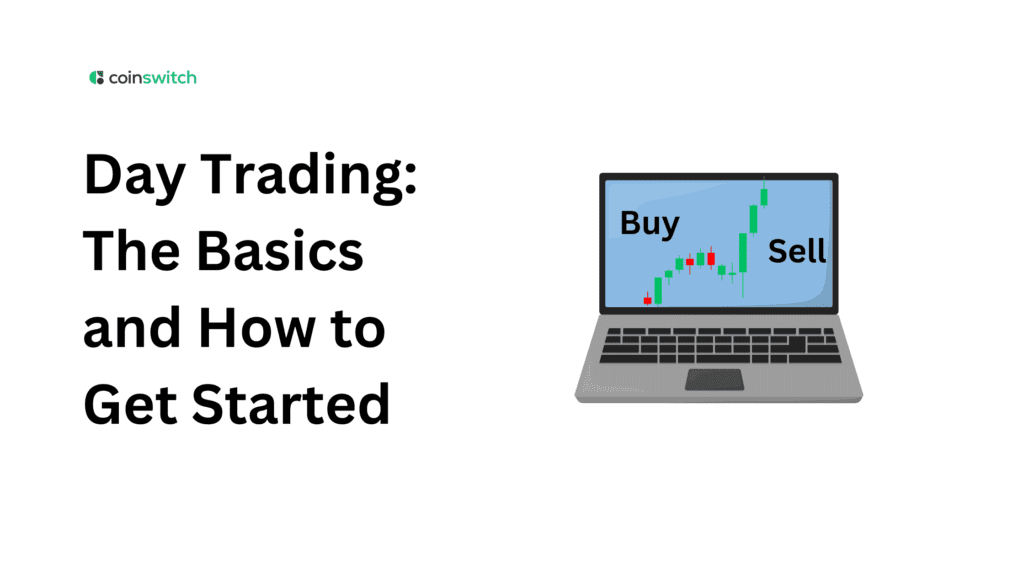Day traders often aim to turn a profit within a few hours or minutes. Real-time data, improved tools, and simplified access empower individual buyers to react swiftly to changes in market prices. Stay alert, prepare yourself, and be aware of potential risks.
Before you jump in, understand the basics and prepare carefully. This blog post provides a guided tour, covering meanings, mechanics, tools, strategies, and pitfalls, including how to do day trading, ensuring you start on a solid footing.
What Is Day Trading?
Day trading is the buying and selling of financial instruments such as stocks, currencies, commodities, or crypto over a single trading day. Day traders seek to profit from short-term price changes rather than holding positions overnight. Typically, traders join and leave the market within minutes or hours.
Day traders rely heavily on technical analysis and market sentiment, setting them apart from traditional investors who focus more on long-term factors. The fast-paced technique demands quick decision-making and adaptation to intraday market changes.
How Does Day Trading Work?
Day trading involves trying to profit from small price changes that occur within the same day. Traders work with current charts and use indicators like moving averages, RSI, and MACD to find the best entry and exit points. Besides, they note liquid, volatile instruments like widely traded stocks, currency pairs, or crypto assets. Online brokerage platforms enable rapid trade execution, often utilizing leverage to deliver profits.
Basically, day trading requires self-control, concentration, and quick reactions. Besides, traders must understand technical indications, analyze multiple data streams at once, and execute with precision, all while staying calm under pressure.
Read More: Arbitrage Strategies with Binary Options
The Attraction of Day Trading
Day trading offers quick money and independence, making it highly desirable. Modern platforms allow traders to trade on the move and exploit intraday volatility in unpredictable ways. There is a psychological pull to pattern spotting, rapid trading, and real-time profit visualization.
In addition, most individuals get to it through commission-free trading and fractional shares, reducing the barriers to entry. However, you must recognize that these advantages come with a high risk and require an in-depth understanding, effective tactics, and unwavering dedication.
Day Trading Rules and Regulations
Day trading in India is subject to rules and regulations devised by the market regulator, the Securities and Exchange Board of India (SEBI). Here are some of the regulations that are applicable to day trading in the Indian market.
· Minimum Account Balance: SEBI does not mandate any specific minimum balance. However, broker can set their limits to maintain sufficient capital to cover margin requirements.
· Margin requirements: For trading in volatile stocks, brokers in India may require higher margins. This can also depend on the broker’s policy.
· Broker compliance: It is advisable to consult your broker to understand compliance requirements and trading limits to avoid penalties.
· Trading restrictions: SEBI has rules that govern short selling and other trading activities. Violations would lead to penalties.
Reporting requirements: Day traders are required to report their trading activities. This applies mostly when the trading volume is significant.
Read More: Swing Trading & Techniques: A Complete Guide
The Basics of Day Trading
For the most part, day trading is all about combining market knowledge with technical analysis and practicing self-control. Traders should apply basic chart-based methods such as momentum or range breakout patterns, and select liquid, volatile assets. Every transaction must include clear entry and exit guidelines backed by risk management techniques, like setting stop-loss levels and limiting exposure to a single trade. Maintain a trading strategy and adhere to it consistently to prevent emotional influence and hasty decisions. Finally, honing strategies through simulation before using real money boosts trader confidence.
How to Start Day Trading
It takes careful planning and focused preparation to start day trading. Hence, this practical guide demonstrates the essential approach from education to implementation, explaining how to do day trading efficiently.
· Thoroughly educate yourself: Master technical analysis, understand market behavior, and grasp trading psychology through tutorials, books, and courses before investing real money.
· Practice via simulators: Enhance your skills through virtual trading platforms. Besides, this approach fosters emotional control, tests strategies, and enhances decision-making for entry and exit without risking actual money.
· Create a trading strategy: Establish your objectives, risk tolerance, and strategy parameters, including the maximum loss per trade and precise entry and exit criteria. Then, strictly adhere to them.
· Select a trustworthy broker: Choose one that provides robust tools, low costs, and fast execution for intraday trading. Ensure platform stability and transparent pricing.
Who Makes a Living by Day Trading?
It is just a small fraction of the population that actually makes a consistent living from day trading. Experienced traders employ effective tactics, and they are single-minded. Some work as professionals for companies or hedge funds.
Some traders operate independently, honing their skills through years of psychological resilience and technical perfection. It can be observed that success often starts with a solid education, managing expectations, and gaining insights from setbacks, rather than chasing excitement or quick profits. A small percentage of committed individuals achieve long-term profitability.
Tools of the Day Trader
In volatile markets, day traders require specific tools to execute quick and accurate actions. These fundamentals—charting, alerts, execution, and analysis—enable traders to recognize setups, manage risk, and execute trades efficiently.
· Advanced Charting Software: These offer real-time charts with technical indicators and multi-timeframe analysis. They also come with algorithmic scanning, automation, drawing facilities, and alerts to help traders quickly and accurately detect opportunities and execute strategies.
· High-Speed Execution Platforms & Reliable Brokers: Low-latency and reliable platforms are needed by traders. These usually have hotkeys, Level II data, and direct market access to execute orders instantly and help reduce missed opportunities in fast markets.
· Stock Screeners & Watchlists: Screeners allow traders to filter instruments based on criteria like volume, volatility, and technical setup. This allows focused watchlists to be set and enables effective market scanning.
· Trade Journals and Backtesting Tools: Recording trades and testing strategies against historical data is essential for traders. It allows them to assess performance, refine tactics, and learn from outcomes in a disciplined manner.
Day Trading Strategies
Day trading methods guide decision-making frameworks to capitalize on intraday trends. This list of popular tactics caters to specific trader preferences and market characteristics.
· Momentum trading: This involves trading on short-term trends. Traders jump in after significant swings and exit when the momentum starts to fade. They rush in when prices increase.
· Gap trading: Identify when equities open significantly higher or lower than their previous close, engage in trades within the initial range breakouts, and seek signs of continuation or reversal.
· Pattern recognition: Trade at breakout or reversal points using chart patterns like triangles or head-and-shoulders to forecast trend shifts.
Risks Involved
The fast pace of day trading inherently increases its risk. Therefore, traders protect themselves and approach markets with caution and control by understanding the potential hazards.
· Prepare to face severe financial losses: Day traders often face significant losses during their initial months of trading, and many fail to achieve profitability.
· Day trading presents a highly stressful full-time job: To spot fleeting market trends, you must concentrate intensely while watching dozens of ticker quotes and price fluctuations.
· Day traders rely significantly on borrowed funds: Day trading tactics use borrowed money to make money. Traders might lose all their money and end up in debt.
How Much Does the Average Day Trader Make?
Day trading earnings fluctuate significantly, influenced by talent, strategy, capital, and discipline. Hence, some traders achieve consistent gains by combining knowledge, managing risk, and leveraging experience, while some find it difficult to break even. It is known that only a small percentage of traders consistently achieve profits, while most lose money in their initial years.
Professional traders collaborating with businesses enjoy greater stability compared to individual retail dealers, who frequently encounter larger risks. Ultimately, focused execution and long-term strategy development determine day trading success, rather than assured profits.
Should You Start Day Trading?
Day trading definitely has its thrills, but it may not be for everyone. Ensure you are analytical, diligent, and willing to dedicate time and effort to learning and practice. Be cautious. However, if you lack a trading strategy, hope to get wealthy quickly, or cannot afford to lose money, proceed with caution.
Besides, many highlight the importance of simulated practice, starting small, and keeping expectations realistic. Many individuals find that long-term investment offers a more sustainable and stress-free option. Only proceed to day trading if you have a strategic mentality, a high level of risk tolerance, and the ability to learn and adjust.
Example
Assume, Aisha, a trader, applies the momentum approach to a highly unpredictable tech stock. She seeks a gap up following better-than-expected earnings and identifies breakout signs within the first 15 minutes of price action. Hence, she enters the market once the price surpasses a critical resistance level, using charting techniques such as moving averages and volume surges.
She establishes a stop-loss marginally under the entry point to ensure a predetermined risk. She closes the deal after an hour, riding the rising trend for a tidy profit. Therefore, she applies a meticulous approach, using technical indicators and strict risk management, demonstrating how day trading works when executed properly.
Day Trading vs. Options Trading
Day trading and options trading both involve brief, active market participation, but they differ in structure and emphasis. Traders buy and sell underlying assets within a single day to take advantage of small price fluctuations, a practice known as day trading.
Options trading involves financial contracts that give traders the right to buy or sell an underlying asset at a predetermined price before a specific expiration date. This adds another layer of complexity and risk. Although options (such as calls, puts, and spreads) provide leverage and strategic flexibility, they also come with complicated pricing behavior, implied volatility, and time decay that must be understood.
As a result, options trading often requires more sophisticated risk management and in-depth technical understanding than simple day trading.
Why Day Trading is Controversial
Day trading is often seen as controversial due to its high failure rate. Besides, it can also lead to emotional strain and financial harm, particularly when driven by unrealistic expectations or hype. Most individual traders lose money, while only a small portion achieve consistent returns, studies show.
Moreover, the fast-paced environment triggers addictive or emotional trading behaviors, drawing comparisons with gambling. Critics highlight that marketing often glamorizes profits and downplays complexity and costs. For disciplined and educated individuals, this path remains viable, but it requires tempered expectations and rigorous preparation.
The Bottom Line
Day trading requires a unique blend of skill, discipline, and resilience. Besides, it offers accessibility and excitement, but it also presents significant risks and a challenging learning curve. Start with education, simulation, and risk control if you’re intrigued. Understand this: long-term investing usually benefits most investors. Pursue day trading only if you are ready to commit seriously, understand its pitfalls, and accept the possibility of losses.
FAQs
1. How to start day trading as a beginner?
Learn basics, choose a reliable broker, start with a demo account, and trade small amounts with a clear strategy.
2. What is the 3-5-7 rule of day trading?
It suggests aiming for 3% daily, 5% weekly, and 7% monthly profit while managing risk carefully.
3. How to earn ₹1000 per day in intraday trading?
Start with sufficient capital, pick liquid stocks, use stop-loss, follow a tested strategy, and avoid overtrading.
4. What is the 2% rule in day trade?
Risk only 2% of your trading capital on a single trade to protect against big losses.








